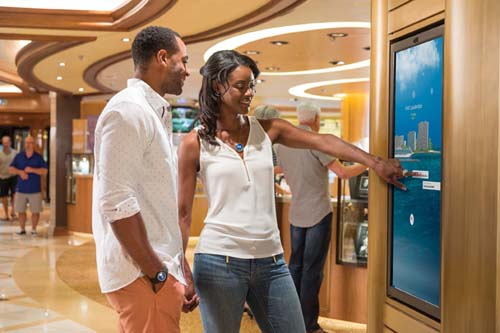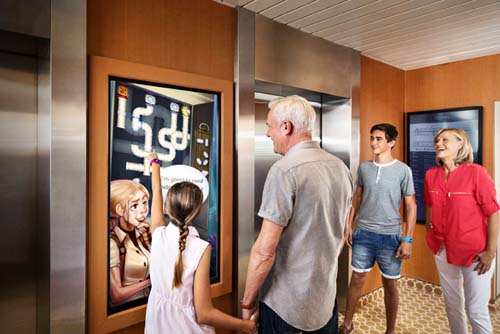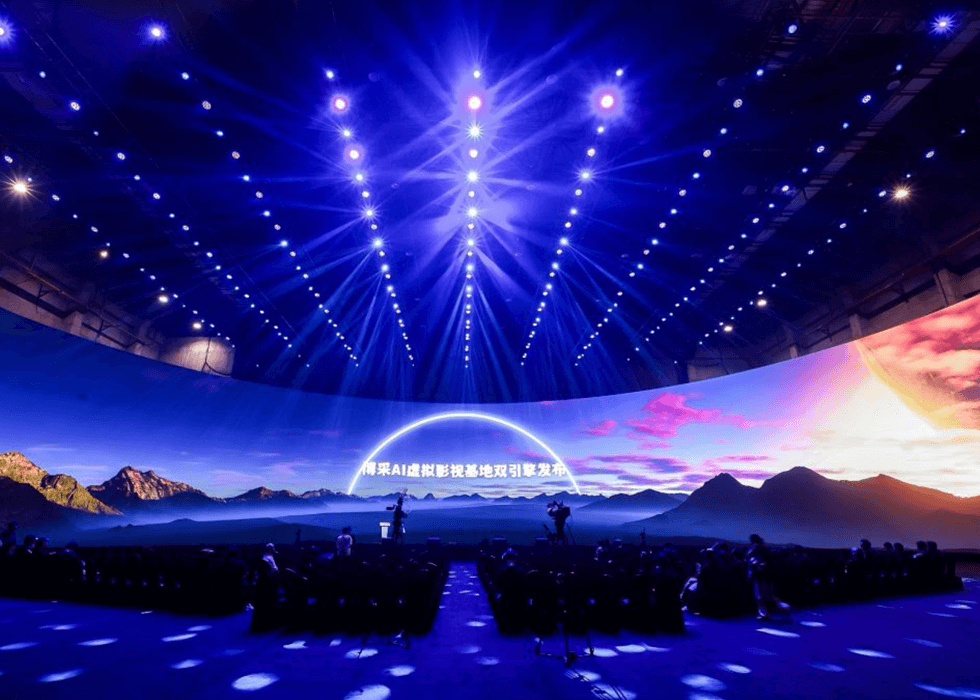AV Tech Elevates the Cruise Experience for Tech-Centric Travelers
By Brad Grimes
The number of worldwide cruise passengers continues to rise every year, and in response, operators are differentiating their ships by modernizing every part of the guest experience.
In addition to new attractions and more time spent at ports, many ships are upgrading their audiovisual technologies to create breathtaking live shows, interactive experiences, more comfortable guest rooms and endless shareable moments for the social media generation.
With a record-breaking 24 new cruise ships planned to launch in 2019, it’s increasingly important for industry decision makers to familiarize themselves with the latest technologies available to elevate the cruise experience.
21st Century Entertainment
 Celebrity Cruises’ newest ship, the Celebrity Edge,
which launched in December 2018, features some of the industry’s most sophisticated audiovisual technologies.
Celebrity Cruises’ newest ship, the Celebrity Edge,
which launched in December 2018, features some of the industry’s most sophisticated audiovisual technologies.
The ship’s main theater includes a new type of cruise show experience, utilizing ten synchronized projection screens, an additional three moving projection screens, 16 video-mapping laser projectors and 154 speakers that immerse every guest in a rich audio and visual experience. Combining the AV technology with the theater’s rotating spiral staircases and aerial performance rigging, the ship launched with five full production shows that use the technology to varying degrees.
“In designing Celebrity Edge, we developed and used some of the most advanced technology available,” said Brian Abel, senior vice president of hotel operations for Celebrity Cruises. “And in designing the entertainment venues on Celebrity Edge, we used those same tools to break the mold of what people think an entertainment venue is.”
Technology also takes center stage at The Club, the main nightclub on Celebrity Edge. The Club features a large-scale overhead LED display used to produce entrancing visuals and light shows, such as the Hypno Cam Experience. This unique, socially-driven dance party features a high-tech camera that’s passed around to capture photos that are instantly shown on the overhead display in a variety of artful depictions, including Andy Warhol-style graphics.
In addition to The Club, other public areas throughout the ship also feature colored LED lighting, including both The Theater and the three-story Grand Plaza. The latter uses LEDs to change the mood of the space as day turns to night, with warm, inviting light giving way to bright, dramatic illumination.
Once guests retreat to their staterooms, they can use a smartphone app to control everything from the temperature to the blackout curtain, and connect to their TV via Bluetooth technology in order to steam their own music.
No Windows? No Problem
While bars, clubs and theaters receive much of the attention when it comes to audiovisual experiences, most cruise guests will spend more than a third of each day in their cabins. Sometimes, interior rooms can feel cramped or stuffy because they don’t have windows.
To create a greater sense of space and connection to the ocean, cruise operators such as Royal Caribbean and Disney are using high-definition display technologies and on-board cameras to simulate windows and balconies that offer real-time views of the surrounding landscape.
Aboard eight of Royal Caribbean’s most popular ships, guests can now book 'virtual balcony' rooms that include an 80-inch vertical display made to look like a balcony door, complete with curtains and a railing. The ships have cameras mounted on the bow and stern that capture full views of the surrounding ocean, and the feeds are delivered in real-time to each room’s virtual balcony. This way, guests can wake up to the real sunrise each morning, and quickly check the current weather.
The view in each room depends on the digital display’s orientation, with some rooms displaying footage from the bow camera and others from the stern. To complete the AV experience, natural sounds, such as waves and wind, are piped into the cabin, and guests can control the volume.
Meanwhile, Disney has outfitted two ships, the Dream and Fantasy, with Magical Portholes —round, LED displays installed above the cabin beds that show a real-time ocean view from cameras mounted on the ship’s exterior. Each view is based on the specific room’s location in the ship. This creative addition gives the interior’s windowless cabins a much-needed feeling of space and connection to the outside world, allowing guests to wake up with the sunrise (or turn it off, if desired).
Creating Shareable Moments
 Cruise operators also are adding audiovisual technologies that almost demand
to be shared via social media, such as the Musical Stairs on Royal Caribbean’s Symphony of the Seas. This creative installation turns a two-tiered staircase into a piano, like in the famous Tom Hanks movie Big.
Cruise operators also are adding audiovisual technologies that almost demand
to be shared via social media, such as the Musical Stairs on Royal Caribbean’s Symphony of the Seas. This creative installation turns a two-tiered staircase into a piano, like in the famous Tom Hanks movie Big.
The integrated AV experience plays music and lights up stairs as guests walk up and down, creating a fun surprise that generates buzz.
Also unique is the ship’s entertainment, which includes a new drone show, 1977, that features synchronized, automated flying of 48 tiny drones, each carrying a small, color-changing light that allows them to appear as a swarm of fireflies in the night. The team responsible for the show created an internal positioning system similar to GPS that accurately controls and automates the drone performance.
Both Musical Stairs and 1977 not only offer guests on-board audiovisual entertainment, but they also create “Instagrammable” moments that amplify the experience far beyond the ship’s decks to a world wide web of prospective customers.
As cruises continue to capture the imagination of increasingly tech-savvy travelers, operators and ship designers can incorporate the latest audiovisual technologies to elevate the on-board experience.
With convenient room controls, one-of-a-kind performance spaces, mood-lighting and the ability to simulate richer cabin experiences, the future of cruise ships is brighter than ever.
This content originally appeared in Future Cruise,
a digital magazine for the cruise industry.





